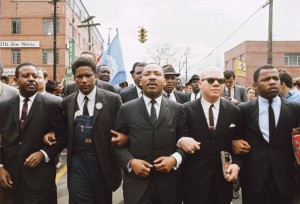 A march to protest at the intimidation which prevented blacks from voting in Dallas County, Alabama. Selma, a city of 29,000, had 15,000 blacks of voting age, of whom only 355 were registered to vote. Martin Luther king chose Selma as he thought whites would resist violently and that this (through television) would draw attention to his cause and force the government to act.
A march to protest at the intimidation which prevented blacks from voting in Dallas County, Alabama. Selma, a city of 29,000, had 15,000 blacks of voting age, of whom only 355 were registered to vote. Martin Luther king chose Selma as he thought whites would resist violently and that this (through television) would draw attention to his cause and force the government to act.
Sheriff Jim Clark, like ‘Bull’ Connor in the Birmingham demonstrations of 1963, was expected to overreact, which he did. King decided to lead a protest march from Selma to the state capital of Montgomery, 56 miles away, where the participants would petition Governor Wallace to protect blacks who wanted to register to vote.
When the march began on 7 March, there followed one of the most vicious assaults in the history of the civil rights movement . Troopers attacked the demonstrators with tear gas, while Clark and his men used bull whips and rubber tubing wrapped in barbed wire. All this was seen on national television. From that time it was clear that Congress would have to act: on 15 March President johnson asked it for a strong new voting rights law.
On 17 March a judge rejected Wallace’s request for a ban on the march and ordered state and local officials not to interfere with it. The march, led by King, began again on 21 March and was successfully completed on the 25th.